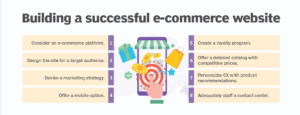In today’s digital economy, an e-commerce website is no longer just an online store — it’s the backbone of modern businesses. Whether you’re a startup or an enterprise, building and scaling an e-commerce platform requires strong IT expertise to ensure performance, security, and customer satisfaction.
In this blog, we’ll explore how the IT field shapes the development, management, and success of e-commerce websites.
Why IT Matters in E-Commerce
An e-commerce website is not just about design and products. Behind the scenes, it relies heavily on IT for:
-
Website Development & Architecture – IT teams build the front-end (user interface) and back-end (databases, servers, APIs) to ensure smooth shopping experiences.
-
Security & Data Protection – With sensitive customer information like payment details and personal data, IT professionals implement SSL encryption, firewalls, and fraud detection systems.
-
Scalability – IT ensures that websites can handle high traffic during sales, festive seasons, or promotions without crashing.
-
Integration with Tools – From payment gateways to inventory management and CRM, IT experts make sure everything works seamlessly.
Key IT Components of an E-Commerce Website
-
Web Development Frameworks
Platforms like Magento, Shopify, WooCommerce, and Laravel provide the foundation, while IT developers customize them for unique business needs. -
Cloud Hosting & Infrastructure
Hosting on AWS, Google Cloud, or Azure ensures uptime, fast load speeds, and global accessibility. -
Cybersecurity
IT teams implement multi-layered security — SSL certificates, 2FA, PCI DSS compliance, and regular vulnerability scans. -
Database Management
Large e-commerce websites rely on MySQL, PostgreSQL, or MongoDB to manage products, orders, and customer data efficiently. -
Automation & AI
IT plays a key role in integrating chatbots, recommendation engines, and personalized marketing to improve user experience.
IT Challenges in E-Commerce
-
Cyber Attacks & Data Breaches – IT must constantly update defenses against hackers.
-
Performance Bottlenecks – Poor coding or lack of server resources can slow websites during peak hours.
-
Third-Party Integration Issues – Payment gateways or logistics APIs can fail without proper IT monitoring.
-
Mobile Responsiveness – With 70% of shoppers buying on mobile, IT ensures a seamless cross-device experience.
Future of IT in E-Commerce
The future of e-commerce websites is being shaped by innovations in IT, such as:
-
Artificial Intelligence (AI) & Machine Learning for predictive analytics and personalized shopping.
-
Blockchain for secure payments and transparent transactions.
-
Augmented Reality (AR) for virtual try-ons in fashion and retail.
-
Headless Commerce where IT teams decouple front-end and back-end for faster, more flexible experiences.
Conclusion
An e-commerce website is much more than an online shop; it’s a complex IT ecosystem that requires continuous development, security, and innovation. Businesses that invest in the right IT infrastructure and expertise can deliver seamless shopping experiences, build customer trust, and stay competitive in the digital marketplace.
If you’re planning to build or upgrade your e-commerce platform, partnering with the right IT team could be the game-changer your business needs.


Great breakdown of how IT underpins a successful e-commerce site. I think scalability is often underestimated — many businesses only realize its importance when a sudden traffic spike causes downtime. Proactive planning for load balancing and infrastructure growth can really make the difference between capitalizing on high-demand moments or losing customers to frustration.